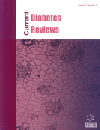- Home
- A-Z Publications
- Current Diabetes Reviews
- Previous Issues
- Volume 2, Issue 3, 2006
Current Diabetes Reviews - Volume 2, Issue 3, 2006
Volume 2, Issue 3, 2006
-
-
Uncoupling Proteins: Role in Insulin Resistance and Insulin Insufficiency
More LessAuthors: Catherine B.Chan and Mary-Ellen HarperUncoupling proteins (UCPs) are modulators of mitochondrial metabolism that have been implicated in the development of both insulin resistance and insulin insufficiency, the two major pathophysiological events associated with type 2 diabetes. UCP2 mRNA is expressed in a wide range of tissues; however UCP2 protein expression is restricted to fewer tissues, including the endocrine pancreas, spleen, stomach, brain and th Read More
-
-
-
Barriers to Achieving Optimal Glycemic Control in a Multi-Ethnic Society: A US Focus
More LessAuthors: Samuel Dagogo-Jack, Martha M. Funnell and Jaime DavidsonThe increasing prevalence of diabetes is particularly apparent in certain ethnic groups, such as African and Hispanic Americans. These groups generally also have poorer glycemic control and outcomes. To better understand the issues surrounding these problems and possible methods to overcome them we performed a literature review from the past 15 years on barriers to glycemic control with a focus on US data. The lit Read More
-
-
-
The Role Played by Serine Proteases in the Development and Worsening of Vascular Complications in Type 1 Diabetes Mellitus
More LessMuch attention has been given to the role played by serine proteases in the development and worsening of vascular complications in Type 1 diabetes mellitus. A generalized increase in proteolytic activity, either due to a true increase in concentration of specific proteases or defects of their protease inhibitors, represents an early marker of diabetes. However, the precise molecular mechanism whereby an unopposed pr Read More
-
-
-
Metformin Beyond Diabetes: New Life for an Old Drug
More LessAuthors: Carlo M. Rotella, Matteo Monami and Edoardo MannucciMetformin is a widely used drug in the therapy of patients affected by diabetes mellitus. Although some caution is needed in the very old, advanced age per se does not represent a contraindication to metformin use. Despite the fact that its precise mechanism of action it is not completely elucidated, long-term treatment with this drug in monotherapy, improves glycaemic control and reduces cardiovascular mortality in ove Read More
-
-
-
Interactions of Endothelin and Insulin: Expanding Parameters of Insulin Resistance
More LessAuthors: Andrew B. Strawbridge, Jeffrey S. Elmendorf and Kieren J. MatherSince the discovery of endothelin peptides in the mid-1980s by Yanigasawa and colleagues, accumulating evidence demonstrates that these peptides may function beyond vasoconstriction. Strong epidemiologic associations between insulin resistance and increased endothelin levels or activity have been found, and these associations have prompted studies investigating the interactions of endothelin with insulin. In this r Read More
-
-
-
Baroreflex Function: Determinants in Healthy Subjects and Disturbances in Diabetes, Obesity and Metabolic Syndrome
More LessAuthors: Ioanna Skrapari, Nicholas Tentolouris and Nicholas KatsilambrosArterial baroreceptors play an important role in the short-term regulation of arterial pressure, by reflex chronotropic effect on the heart and by reflex regulation of sympathetic outflow. Baroreflex sensitivity (BRS) represents an index of arterial baroreceptors function. Several methods of measuring BRS are available nowadays. Different factors influence BRS in the healthy population, including sex, age, blood pressure, he Read More
-
-
-
Therapeutic Management Strategies for Type 2 Diabetes
More LessAuthors: C. Ramesh, V. Gopal, K. Sembulingam and M. NappinnaiDiabetes mellitus type 1 and 2 affects people worldwide and is associated with further complications like macrovascular, microvascular and its effect is observed as retinopathy, cardiovascular diseases, nephropathy and many more diseases. There are numerous suggestions, treatments for presentation and controlling diabetes but no curative agents. Therefore the aim is to prevent or delay onset or control the complications Read More
-
-
-
Diagnosis and New Approaches in the Therapy of Gestational Diabetes Mellitus
More LessAuthors: Ute M. Schaefer-Graf and Helmut KleinwechterGestational diabetes mellitus (GDM) is one of the most common complications in pregnancy. It affects 3-15% of women, depending on the background diabetes risk of the population and applied diagnostic criteria. GDM is associated with neonatal problems such as macrosomia and neonatal hypoglycemia as well as a long term increased risk of diabetes and obesity of offspring. Current therapy of GDM focuses on tig Read More
-
-
-
Diagnostic Tools for Diabetic Sensorimotor Polyneuropathy
More LessAuthors: Keri A. Kles and Vera BrilDiabetes and its complications are major causes of mortality in the United States, with increasing rates of morbidity and increasing health care costs. Patients diagnosed with diabetes attempt to control cholesterol levels, blood pressure, and blood glucose levels to decrease the risk of diabetic microvascular complications (DMC), such as diabetic sensorimotor polyneuropathy (DSP) [also known as diabetic peripheral neu Read More
-
-
-
The Role of PTB in Insulin mRNA Stability Control
More LessAuthors: Rickard G. Fred, Linda Tillmar and Nils WelshAlthough extensively studied, there are still many unanswered questions regarding the regulation of insulin gene expression. This is important to further investigate since it will help us understand the pathophysiology of some types of diabetes. The insulin mRNA has a long half-life and changes in insulin mRNA stability, induced by glucose, are likely to be regulated through specific mechanisms. Recent findings indicate that the p Read More
-
Volumes & issues
-
Volume 21 (2025)
-
Volume 20 (2024)
-
Volume 19 (2023)
-
Volume 18 (2022)
-
Volume 17 (2021)
-
Volume 16 (2020)
-
Volume 15 (2019)
-
Volume 14 (2018)
-
Volume 13 (2017)
-
Volume 12 (2016)
-
Volume 11 (2015)
-
Volume 10 (2014)
-
Volume 9 (2013)
-
Volume 8 (2012)
-
Volume 7 (2011)
-
Volume 6 (2010)
-
Volume 5 (2009)
-
Volume 4 (2008)
-
Volume 3 (2007)
-
Volume 2 (2006)
-
Volume 1 (2005)
Most Read This Month
Article
content/journals/cdr
Journal
10
5
false
en


